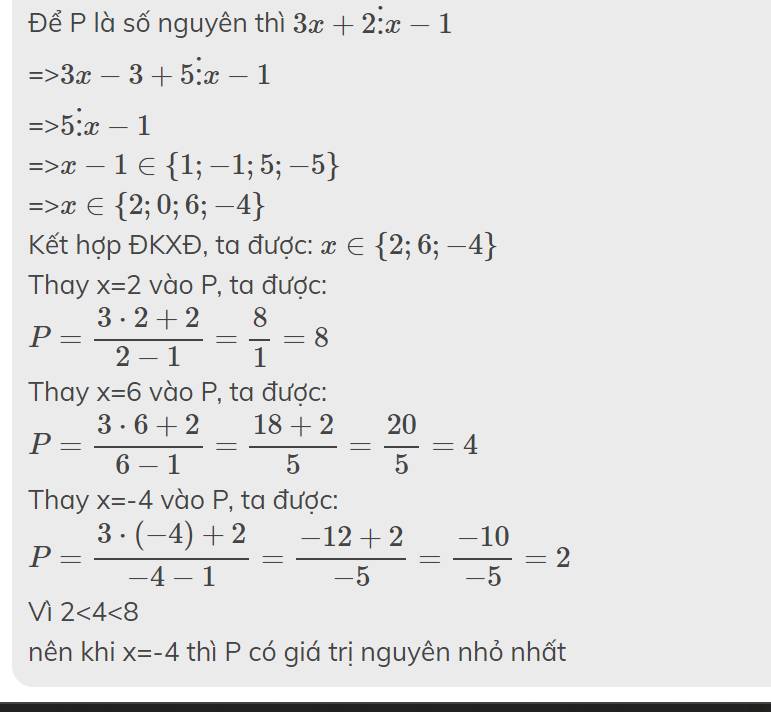Tính giá trị biểu thức A=x\(^2\)-3x+1 khi |x+\(\dfrac{1}{3}\)|=\(\dfrac{2}{3}\)
Hãy nhập câu hỏi của bạn vào đây, nếu là tài khoản VIP, bạn sẽ được ưu tiên trả lời.


a: \(A=\left(\dfrac{x}{\left(x-2\right)\left(x+2\right)}-\dfrac{2}{x-2}+\dfrac{1}{x+2}\right)\cdot\dfrac{x+2}{6}\)
\(=\dfrac{x-2x-4+x-2}{\left(x+2\right)\left(x-2\right)}\cdot\dfrac{x+2}{6}=\dfrac{-6}{6}\cdot\dfrac{1}{x-2}=\dfrac{-1}{x-2}\)
b: x=2 ko thỏa mãn ĐKXĐ
=>Loại
Khi x=3 thì A=-1/(3-2)=-1
c: A=2
=>x-2=-1/2
=>x=3/2

Giải:
Ta có:
|x+1/3|=2/3
⇒x+1/3=2/3 hoặc x+1/3=-2/3
x=1/3 hoặc x=-1
+)TH1: (nếu như có ngoặc)
Khi x=1/3:
A=(1/3)2-3.(1/3)+1
A=1/9
Khi x=-1
A=(-1)2-3.(-1)+1
A=5
+)TH2: (nếu x ko có ngoặc)
Khi x=-1
A=-12-3.-1+1
A=3
Trường hợp này chỉ có -1 vì 1/3 2 =1/9 ; còn ko có ngoặc hay có ngoặc còn tùy thuộc vào đề bài và cách suy nghĩ của bạn nhé!
Chúc bạn học tốt!

a: Thay x=5 vào B, ta được:
\(B=\dfrac{5-1}{5-3}=\dfrac{4}{2}=2\)
b: \(A=\dfrac{2x^2+6x-2x^2-3x-1}{\left(x-3\right)\left(x+3\right)}=\dfrac{3x-1}{\left(x+3\right)\left(x-3\right)}\)

a) Ta có: \(A=\left(\dfrac{2\sqrt{x}}{\sqrt{x}+3}-\dfrac{\sqrt{x}}{3-\sqrt{x}}-\dfrac{3x+3}{x-9}\right):\dfrac{\sqrt{x}+1}{\sqrt{x}-3}\)
\(=\dfrac{2x-6\sqrt{x}+x+3\sqrt{x}-3x-3}{\left(\sqrt{x}+3\right)\left(\sqrt{x}-3\right)}\cdot\dfrac{\sqrt{x}-3}{\sqrt{x}+1}\)
\(=\dfrac{-3\sqrt{x}-3}{\sqrt{x}+3}\cdot\dfrac{1}{\sqrt{x}+1}\)
\(=\dfrac{-3}{\sqrt{x}+3}\)
b) Ta có: \(x=\sqrt{3+2\sqrt{2}}-\sqrt{3-2\sqrt{2}}\)
\(=\sqrt{2}+1-\sqrt{2}+1\)
=2
Thay x=2 vào A, ta được:
\(A=\dfrac{-3}{3+\sqrt{2}}=\dfrac{-9+3\sqrt{2}}{7}\)

ĐKXĐ : \(x\ne0;x\ne\pm1\)
a) Bạn ghi lại rõ đề.
b) \(B=\dfrac{x-1}{x+1}+\dfrac{3x-x^2}{x^2-1}=\dfrac{x-1}{x+1}+\dfrac{3x-x^2}{\left(x-1\right).\left(x+1\right)}\)
\(=\dfrac{\left(x-1\right)^2+3x-x^2}{\left(x-1\right).\left(x+1\right)}=\dfrac{x+1}{\left(x-1\right).\left(x+1\right)}=\dfrac{1}{x-1}\)
c) \(P=A.B=\dfrac{x^2+x-2}{x.\left(x-1\right)}=\dfrac{\left(x-1\right).\left(x+2\right)}{x\left(x-1\right)}=\dfrac{x+2}{x}=1+\dfrac{2}{x}\)
Không tồn tại Min P \(\forall x\inℝ\)

a: ĐKXĐ: \(x\notin\left\{0;1;2;3;4;5\right\}\)
b: \(P=\dfrac{1}{x^2-x}+\dfrac{1}{x^2-3x+2}+\dfrac{1}{x^2-5x+6}+\dfrac{1}{x^2-7x+12}+\dfrac{1}{x^2-9x+20}\)
\(=\dfrac{1}{x\left(x-1\right)}+\dfrac{1}{\left(x-1\right)\left(x-2\right)}+\dfrac{1}{\left(x-2\right)\left(x-3\right)}+\dfrac{1}{\left(x-3\right)\left(x-4\right)}+\dfrac{1}{\left(x-4\right)\left(x-5\right)}\)
\(=\dfrac{-1}{x}+\dfrac{1}{x-1}-\dfrac{1}{x-1}+\dfrac{1}{x-2}-\dfrac{1}{x-2}+\dfrac{1}{x-3}-\dfrac{1}{x-3}+\dfrac{1}{x-4}-\dfrac{1}{x-4}+\dfrac{1}{x-5}\)
\(=\dfrac{1}{x-5}-\dfrac{1}{x}\)
\(=\dfrac{x-\left(x-5\right)}{x\left(x-5\right)}=\dfrac{5}{x\left(x-5\right)}\)
c: \(x^3-x^2+2=0\)
=>\(x^3+x^2-2x^2+2=0\)
=>\(x^2\cdot\left(x+1\right)-2\left(x-1\right)\left(x+1\right)=0\)
=>\(\left(x+1\right)\left(x^2-2x+2\right)=0\)
=>x+1=0
=>x=-1
Khi x=-1 thì \(P=\dfrac{5}{\left(-1\right)\left(-1-5\right)}=\dfrac{5}{\left(-1\right)\cdot\left(-6\right)}=\dfrac{5}{6}\)

a) \(A=\dfrac{x^2+3x}{x^2-25}+\dfrac{1}{x+5};B=\dfrac{x-5}{x+2}\left(x\ne\pm5;-2\right)\)
Khi \(x=9\) thì :
\(B=\dfrac{9-5}{9+2}=\dfrac{4}{11}\)
b) \(P=A.B\)
\(\Leftrightarrow P=\left[\dfrac{x^2+3x}{x^2-25}+\dfrac{1}{x+5}\right].\dfrac{x-5}{x+2}\)
\(\Leftrightarrow P=\left[\dfrac{x^2+3x}{\left(x+5\right)\left(x-5\right)}+\dfrac{x-5}{\left(x+5\right)\left(x-5\right)}\right].\dfrac{x-5}{x+2}\)
\(\Leftrightarrow P=\left[\dfrac{x^2+4x-5}{\left(x+5\right)\left(x-5\right)}\right].\dfrac{x-5}{x+2}\)
\(\Leftrightarrow P=\left[\dfrac{x^2+5x-x-5}{x+5}\right].\dfrac{1}{x+2}\)
\(\Leftrightarrow P=\left[\dfrac{x\left(x+5\right)-\left(x+5\right)}{x+5}\right].\dfrac{1}{x+2}\)
\(\Leftrightarrow P=\left[\dfrac{\left(x+5\right)\left(x-1\right)}{x+5}\right].\dfrac{1}{x+2}\)
\(\Leftrightarrow P=\dfrac{x-1}{x+2}\)
c) Theo đề bài để
\(P=\dfrac{x-1}{x+2}>\dfrac{1}{3}\left(x>-2\right)\)
\(\Leftrightarrow3\left(x-1\right)>x+2\)
\(\Leftrightarrow3x-3>x+2\)
\(\Leftrightarrow2x>5\)
\(\Leftrightarrow x>\dfrac{5}{2}\left(thỏa,đk:x>-2\right)\)
a) Để tính giá trị của B khi x = 9, ta thay x = 9 vào biểu thức B: B = (x - 5)/(x + 2) - 5/(x + 2) = (9 - 5)/(9 + 2) - 5/(9 + 2) = 4/11 - 5/11 = -1/11
Vậy giá trị của B khi x = 9 là -1/11.
b) Để rút gọn biểu thức P = A.B, ta nhân các thành phần tương ứng của A và B: P = (x^2 + 3x)/(x^2 - 25 + 1) * (x - 5)/(x + 2) = (x(x + 3))/(x^2 - 24) * (x - 5)/(x + 2) = (x(x + 3)(x - 5))/(x^2 - 24)(x + 2)
Vậy biểu thức P được rút gọn thành P = (x(x + 3)(x - 5))/(x^2 - 24)(x + 2).
c) Để tìm giá trị của x khi P > 13 với x > -2, ta giải phương trình: (x(x + 3)(x - 5))/(x^2 - 24)(x + 2) > 13


\(\left|x+\dfrac{1}{3}\right|=\dfrac{2}{3}\Leftrightarrow\left[{}\begin{matrix}x+\dfrac{1}{3}=\dfrac{2}{3}\\x+\dfrac{1}{3}=-\dfrac{2}{3}\end{matrix}\right.\)
\(\Rightarrow\left[{}\begin{matrix}x=\dfrac{1}{3}\\x=-1\end{matrix}\right.\)
- Với \(x=\dfrac{1}{3}\Rightarrow A=\left(\dfrac{1}{3}\right)^2-3.\dfrac{1}{3}+1=\dfrac{1}{9}\)
- Với \(x=-1\Rightarrow A=\left(-1\right)^2-3\left(-1\right)+1=5\)